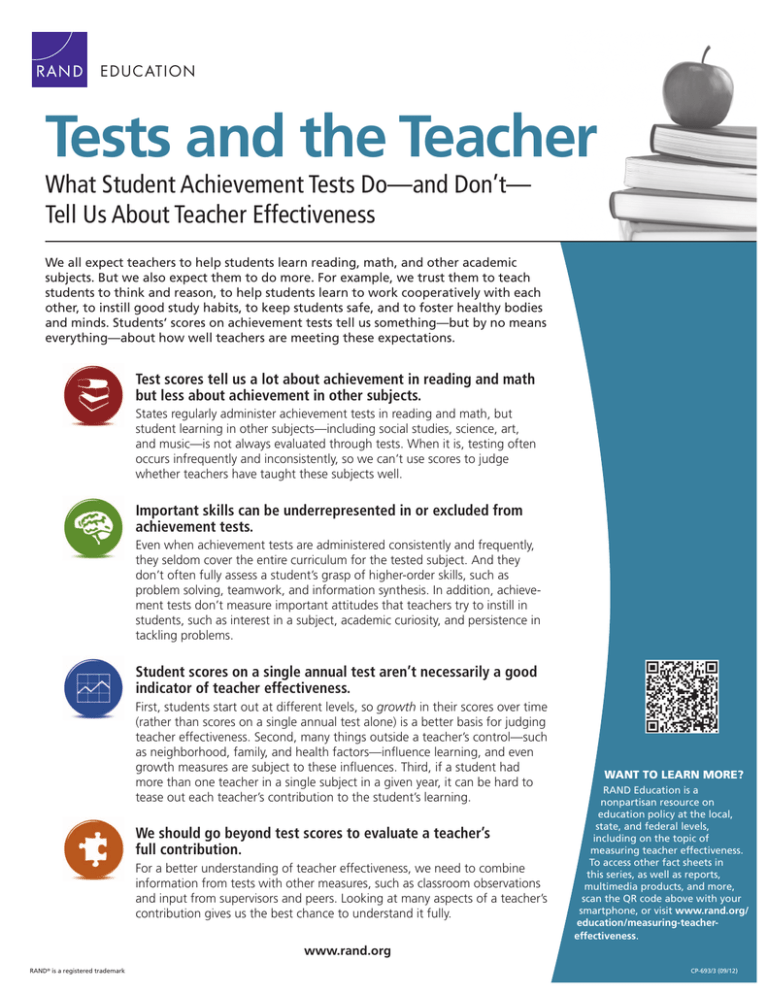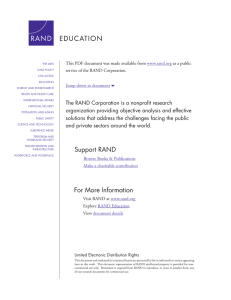Tests and the Teacher What Student Achievement Tests Do—and Don’t— EDUCATION
advertisement

E D U C AT I O N Tests and the Teacher What Student Achievement Tests Do—and Don’t— Tell Us About Teacher Effectiveness We all expect teachers to help students learn reading, math, and other academic subjects. But we also expect them to do more. For example, we trust them to teach students to think and reason, to help students learn to work cooperatively with each other, to instill good study habits, to keep students safe, and to foster healthy bodies and minds. Students’ scores on achievement tests tell us something—but by no means everything—about how well teachers are meeting these expectations. Test scores tell us a lot about achievement in reading and math but less about achievement in other subjects. States regularly administer achievement tests in reading and math, but student learning in other subjects—including social studies, science, art, and music—is not always evaluated through tests. When it is, testing often occurs infrequently and inconsistently, so we can’t use scores to judge whether teachers have taught these subjects well. Important skills can be underrepresented in or excluded from achievement tests. Even when achievement tests are administered consistently and frequently, they seldom cover the entire curriculum for the tested subject. And they don’t often fully assess a student’s grasp of higher-order skills, such as problem solving, teamwork, and information synthesis. In addition, achievement tests don’t measure important attitudes that teachers try to instill in students, such as interest in a subject, academic curiosity, and persistence in tackling problems. Student scores on a single annual test aren’t necessarily a good indicator of teacher effectiveness. First, students start out at different levels, so growth in their scores over time (rather than scores on a single annual test alone) is a better basis for judging teacher effectiveness. Second, many things outside a teacher’s control—such as neighborhood, family, and health factors—influence learning, and even growth measures are subject to these influences. Third, if a student had more than one teacher in a single subject in a given year, it can be hard to tease out each teacher’s contribution to the student’s learning. We should go beyond test scores to evaluate a teacher’s full contribution. For a better understanding of teacher effectiveness, we need to combine information from tests with other measures, such as classroom observations and input from supervisors and peers. Looking at many aspects of a teacher’s contribution gives us the best chance to understand it fully. WANT TO LEARN MORE? RAND Education is a nonpartisan resource on education policy at the local, state, and federal levels, including on the topic of measuring teacher effectiveness. To access other fact sheets in this series, as well as reports, multimedia products, and more, scan the QR code above with your smartphone, or visit www.rand.org/ education/measuring-teachereffectiveness. www.rand.org RAND is a registered trademark ® CP-693/3 (09/12)





